NM-279
Impact of an intraoperative blood transfusion protocol on perioperative transfusion for craniosynostosis surgery.
Masaracchia M, Fernandez P
Children's Hospital Colorado, Aurora, CO, United states
Introduction
Children undergoing craniofacial reconstruction are at risk for blood transfusion due to substantial blood loss. In 2016, we deployed intraoperative transfusion guidelines based on clinical evidence identifying laboratory triggers and goals for transfusion. To assess perioperative transfusion practices before and after implementation, we queried our craniofacial database for all children who underwent craniosynostosis repair. We hypothesized that complying with intraoperative transfusion guidelines would reduce transfusion and blood product exposure.
Methods
After QI panel approval, query of the pediatric craniofacial surgery perioperative registry identified children who underwent cranial vault surgery at our institution between October 2013 and October 2017. Patients were divided into 2 cohorts (pre-protocol and post-protocol) based on the implementation of transfusion guidelines on November 1, 2016. Demographic and perioperative data was extracted. Sub-analyses were conducted with respect to simple versus complex cranial vault reconstruction (CCVR); CCVR being previously defined as frontoorbital advancement/anterior vault, middle/posterior cranial vault or total cranial vault reconstruction.
Results
As this is an ongoing study, we analyzed data from 149 patients in the pre-protocol group and 54 patients post-protocol. Both cohorts had similar patient demographics and clinical characteristics. Overall, when compared to the pre-protocol group, the post-protocol group showed a small reduction in the prevalence of packed red-blood cell (PRBC) transfusion (from 91% to 87%); however, PRBC transfusion volumes (mL/kg) dropped by 22%. When subdivided into simple and complex repairs – there was an overall 10% reduction in percent transfused in the post-protocol simple group and an 18% reduction in PRBC volume. A much smaller effect was seen in complex repairs. Length of stay and the incidence of post-operative transfusion were unchanged by protocol implementation.
Discussion
Our preliminary data suggests that intraoperative transfusion protocols may be beneficial in patients undergoing simple cranial vault reconstruction, but perhaps not in CCVR. Although, the reduction was less significant than anticipated, we suspect this may be due to poor adherence to protocol guidelines in the first few months of inception and expect improvement with time. This is reflected by postoperative hematocrits being greater than dictated by the protocol. Despite a reduction in intraoperative transfusion for simple repairs, there was not an increase in post-operative transfusion.
Conclusions
Adherence to a strict intraoperative transfusion protocol is likely to decrease intraoperative transfusion of PRBCs in simple pediatric cranial vault reconstruction.
References:
Stricker PA et al. Perioperative Outcomes and Management in Pediatric Complex Cranial Vault Reconstruction: A Multicenter Study from the PCCG. Anes. 2017; 126:276-87
Top












